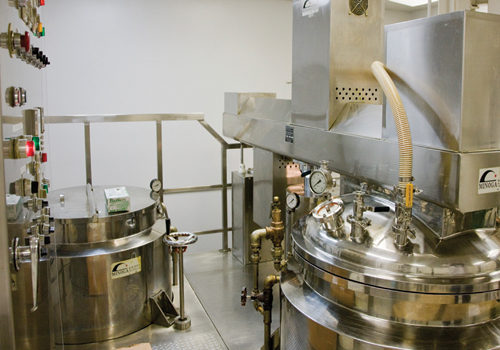Photo courtesy of Soft Gel Technologies, Inc.
Positive contract manufacturing relationships are all about meeting and exceeding expectations. Seeing eye to eye, being on the same wavelength, having one’s clocks synchronized…these are crucial factors for the success of any partnership between manufacturer and finished product marketer. “It is never a good practice to over-promise and under-perform,” notes Richard Kaufman, executive vice president of Paragon Laboratories, Torrance, CA.
He emphasizes that his company, like all contract manufacturers, is a customer service organization first and foremost. No matter how sophisticated, experienced or knowledgeable the product marketer may be, the client will still have questions that need answering and certain expectations (not to mention product orders) that need to be fulfilled.
Before We Do This…
 Worrying can be a good thing when it comes to contract manufacturing, for both manufacturers and their clients. It may lead to safe and effective products, as well as a smooth production cycle where everyone gets what they need, when they need it. Therefore, potential clients are always posing pressing questions to their contract manufacturers, before any actual pressing or encapsulation gets done.
Worrying can be a good thing when it comes to contract manufacturing, for both manufacturers and their clients. It may lead to safe and effective products, as well as a smooth production cycle where everyone gets what they need, when they need it. Therefore, potential clients are always posing pressing questions to their contract manufacturers, before any actual pressing or encapsulation gets done.
Concerns over product quality and label claims pop up most often these days, according to Joe Archer, vice president of sales and marketing at All American Pharmaceutical, Billings, MT. In addition to customers looking for assurance that their products will be of consistent purity and quality, Archer says, “Our customers want to know the product they will be getting is exactly what is stated on the label in the precise amounts that are stated.”
The type of queries contract manufacturers receive can often depend on what the potential client brings to the table. A company just starting out in the industry is often concerned about turnaround times for both quotes and the finished products themselves, along with pricing, says Jason Provenzano, president and founder of Nutricap Labs, Farmingdale, NY. On the flip side, more established marketers looking for a new manufacturer often lead off with questions about which ingredients are in the manufacturer’s inventory of raw materials, good manufacturing practice (GMP) certification of its facilities and other production-related services they offer, like packaging, label design or order fulfillment.
Priorities in order. One specific concern that gets addressed before any contract is signed, or as existing contracts get worked over and renewed, is the manufacturing capacity being offered. Marketers need to know: How large (or how small) can our product runs be? And (what is often more important), what will you do for us when we need product in a crunch?
Kaufman and others conclude that fulfilling large product runs or rush orders is often a matter of rejiggering one aspect of production or another. Working with customers on their supply needs can involve rearranging schedules to suit multiple clients, or even partial order shipments if the need is there, Kaufman says.
 Maintaining a flexible schedule means almost always accommodating customer orders, explains Steve Holtby, president and CEO of Soft Gel Technologies, Inc., Los Angeles, CA. Stocking currently popular products and making them constantly available for shipment in small quantities is one way to maintain this readiness. But, there are constraints, Holtby says, stating, “We are limited by GMP regulations and raw material availability—we still have to test all ingredients and assess quality throughout the manufacturing process.” Adds Shabbir Akand, vice president of sales and marketing at NHK Laboratories, Inc., Santa Fe Springs, CA, “That’s the main thing that can be the major hurdle—is the raw material available?”
Maintaining a flexible schedule means almost always accommodating customer orders, explains Steve Holtby, president and CEO of Soft Gel Technologies, Inc., Los Angeles, CA. Stocking currently popular products and making them constantly available for shipment in small quantities is one way to maintain this readiness. But, there are constraints, Holtby says, stating, “We are limited by GMP regulations and raw material availability—we still have to test all ingredients and assess quality throughout the manufacturing process.” Adds Shabbir Akand, vice president of sales and marketing at NHK Laboratories, Inc., Santa Fe Springs, CA, “That’s the main thing that can be the major hurdle—is the raw material available?”
There are certain steps in the production process with built-in lag time that can’t be maneuvered around so easily. According to Akand, these elements can include qualifying the vendor, procuring the needed raw materials and then verifying their identity through a battery of tests. After that comes the actual manufacturing and in-process testing, capped off by packaging. Without comprising or taking shortcuts on any of these requirements, he says that some things can be juggled to allow for quick turnarounds, like setting aside any orders that are getting done sooner than needed.
Last-minute adjustments like these aren’t needed very often, though, according to Akand. For one thing, the actual manufacturing processes for the dietary supplements his company deals with simply don’t take long—on the order of hours or a few days.
Basic manufacturing capacity is dependent in part on equipment capabilities. State-of-the-art blenders, tablet presses and encapsulation machines allow for large production runs and quick project completion, according to Provenzano. When possible, keeping the raw materials necessary for various products at the manufacturing facility can also help jumpstart things when an order needs to be filled. Then, there are those impromptu actions a manufacturer can sometimes take to help out its clients. Provenzano cites the example of his company fielding a call from someone who was working with another manufacturer that closed due to GMP violations, and who was therefore in a bind for product. Provenzano’s company went out and purchased a specific piece of machinery necessary for that product in order to meet the deadline.
Supply and demand. Similarly, customers may have 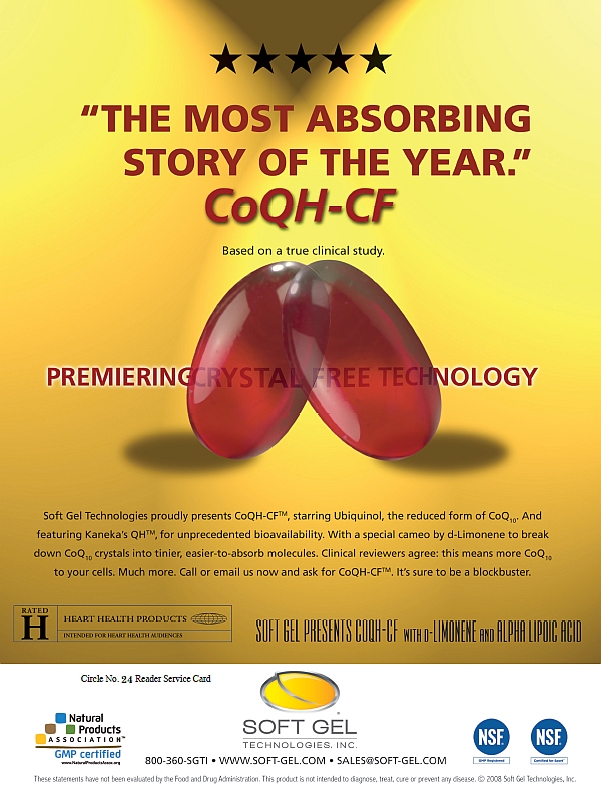 questions about the manufacturer’s ability to handle fluctuations in demand for their products at any given time. The key to avoiding problems is simple, and is encapsulated in the Five “Ps” Rule, as stated by Thomas T. Tierney, CEO of VitaTech Nutritional Sciences, Inc., Tustin, CA: Prior Planning Precludes Poor Performance. This means careful planning on the part of the manufacturer, and in conjunction with the marketer as dictated by their sales expectations.
questions about the manufacturer’s ability to handle fluctuations in demand for their products at any given time. The key to avoiding problems is simple, and is encapsulated in the Five “Ps” Rule, as stated by Thomas T. Tierney, CEO of VitaTech Nutritional Sciences, Inc., Tustin, CA: Prior Planning Precludes Poor Performance. This means careful planning on the part of the manufacturer, and in conjunction with the marketer as dictated by their sales expectations.
For manufacturers, investments in facilities and labor can yield results when customers need them most. In the case of Tierney’s company, whether it is adding 30% capacity to a production run using a single shift, or instituting a full second shift to double capacity, he says to “bring on the crunch!”
Major issues in this department can generally be avoided altogether. “Most problems related to product supply can be solved with a little foresight and planning,” claims Yusuf Ishaq, sales manager for GMP Laboratories of America, Inc., Anaheim, CA. Ideally, a client will provide the manufacturer with a forecast or projection for the upcoming months or quarters, he says.
But one major media mention might send demand through the roof. “Naturally, the actual numbers deviate from the forecasts and our company and processes are flexible enough to allow these variations to not become a major hindrance,” Ishaq says. If customers are well-established in the market with their product, he says they are often encouraged to place blanket orders that enable the manufacturer to secure raw materials far in advance for when demand ramps up.
Another option described by Akand is vendor-managed inventory (VMI). Based on order rates from the previous year and plenty of discussions with the client, the manufacturer will develop a production plan to move forward with. More specific preparations sometimes need to take place, such as if a client’s product makes use of a material that is hard to come by. Made-to-order raw materials (such as probiotics, enzymes and flavored items like chewable vitamins or powder formulations) sent from the manufacturer’s own supplier can take three weeks from when the order is placed to arrive, says Akand. They need to be made fresh, because stability and shelf life is sometimes fragile or short.
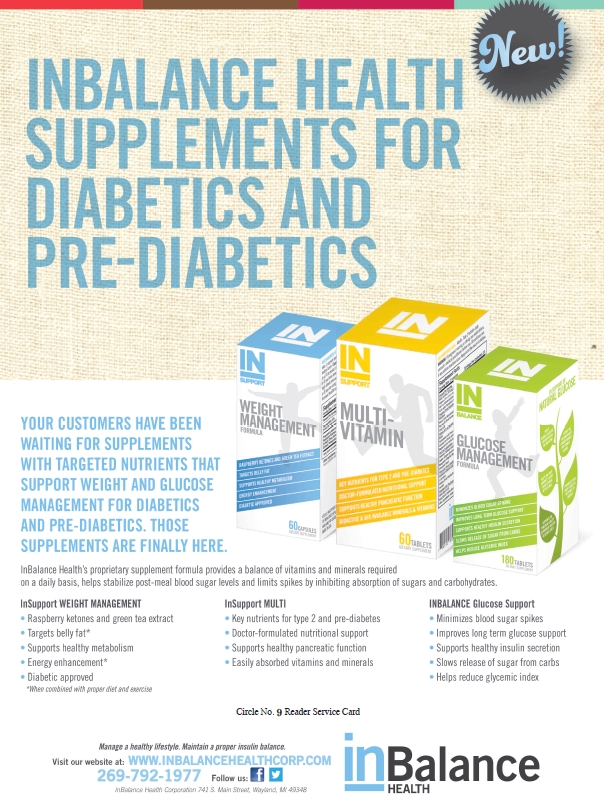 Finally, manufacturers must expect the unexpected. Harvest issues and other causes of short supply can cause glitches in the supply chain, along with orders for hot items. Akand cites beta-alanine as an example of a raw material that has faced shortages in the past, and green coffee bean extract as one item hard to get one’s hands on at the moment due to popularity. Eugene Ung, CEO of Best Formulations, City of Industry, CA, also describes the supply issues that can sometimes arise. “The challenge we have today is with raw materials, as most suppliers are keeping less inventory on the floor, and there are various factors that can affect supply,” including low harvest yields, increases in commodity price and others.
Finally, manufacturers must expect the unexpected. Harvest issues and other causes of short supply can cause glitches in the supply chain, along with orders for hot items. Akand cites beta-alanine as an example of a raw material that has faced shortages in the past, and green coffee bean extract as one item hard to get one’s hands on at the moment due to popularity. Eugene Ung, CEO of Best Formulations, City of Industry, CA, also describes the supply issues that can sometimes arise. “The challenge we have today is with raw materials, as most suppliers are keeping less inventory on the floor, and there are various factors that can affect supply,” including low harvest yields, increases in commodity price and others.
Protecting core competencies. Marketers with successful and unique product formulations, or with product concepts that position them uniquely in the market, might worry about what contract manufacturers will take away from their association with them besides money.
They can rest assured that this is not how contract manufacturers typically operate. On the contrary, they hold the integrity of the client’s information in high regard. “If a customer comes to us with a custom formula, we create a turnkey product for them that is manufactured exclusively for them. We will not produce it for anyone else,” explains Holtby.
A basic policy of non-disclosure is appropriate with regard to client formulas. If the company’s good word is not enough, according to Akand, different kinds of non-disclosure agreements (NDAs) can be put in place. After all, in their formulas, clients are sometimes bringing proprietary information to the production floor. “It’s the recipe, and we’re the cook. We manufacture the product for them to meet their label claim,” says Akand. At the same time, the proprietary information belonging to the contract manufacturer, such as how a blend is created or how tablets are compressed, isn’t always disclosed to the client, but they aren’t typically concerned with this anyway, he adds. If his company ever ceases to do business with a client, any unique formulations it manufactured are kept strictly confidential.
Provenzano reminds us of the reasons that marketers go the contract manufacturing route in the first place. In part, it’s to grant themselves more time and resources to grow their businesses. Despite any misgivings, it may be helpful for them to remember that their contract manufacturer should, and usually does, have their best interests in mind.
Regulations: Shared Liability, Or You’re on Your Own?
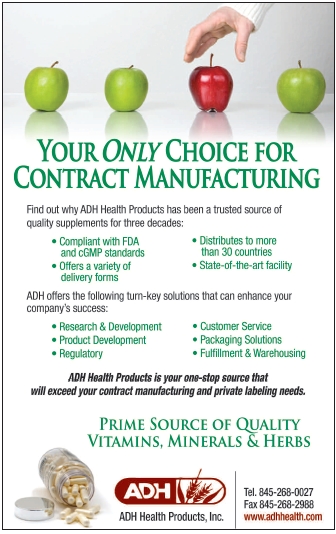 Just as a contract manufacturer and client are partners in business, they are also inseparable in their responsibility for abiding by federal product manufacturing and marketing regulations.
Just as a contract manufacturer and client are partners in business, they are also inseparable in their responsibility for abiding by federal product manufacturing and marketing regulations.
Archer lays out one way to sensibly divide up that responsibility, starting with some definitions: “If a product has an ingredient in it that isn’t on the label, it is adulterated. If the product has an ingredient on the label that is not in the product, it is misbranded.” Manufacturers, he says, are responsible for ensuring that the end product matches up with exactly what’s on the label. Marketers need to make sure the label lists all ingredients correctly, matching up with the manufacturer’s specification sheet for the product, and that it is then marketed accurately.
Abiding by the applicable provisions in 21 CFR Part 111 regarding current GMPs is everyone’s responsibility down the supply chain, from the raw material supplier to the manufacturer to the marketer, says Ishaq. If a regulatory issue arises, circumstances can dictate whether or not regulatory liability is shared, he says.
When there is shared liability, it is usually incumbent upon the contract manufacturer to have its paperwork in order. According to Akand, the paper trail required from qualifying vendors, testing raw materials and performing in-process and finished-product testing can come into play in the event a client is inspected by the U.S. Food and Drug Administration (FDA).
The imposition of formal GMPs has changed the manufacturing game. “It’s all about testing when it comes to GMPs; saying what you do and doing what you say,” says Akand. FDA does not necessarily tell manufacturers how to do their jobs down to letter, but the agency’s requirements must nevertheless be met. Akand says the 21 CFR 111 guidelines are written quite loosely, and thus subject to interpretation. His company maintains a protocol of modeling their operations after pharmaceutical GMPs. Because of its potential importance, he says clients should look into the GMP compliance of their manufacturers; just as contract manufacturers should audit their suppliers, marketers should audit theirs.
As a general rule, Akand says it is expected that the research behind and the goals held for a product formulation by its marketer are acceptable. A product’s interaction with the end user is, after all, the responsibility of the marketer. He emphasizes that as a contract manufacturer, his firm will only consider ingredients protected under the Dietary Supplements Health and Education Act (DSHEA) as safe, and will let potential clients know when this is not the case. “The actual manufacturing of that product to label claim, free of adulterants, free of any other foreign ingredients other than what the label claims, that is our assurance to the marketer,” Akand says. Qualifying raw materials that they procure themselves is also their responsibility as manufacturer. The product label, however, is the purview of the marketer.
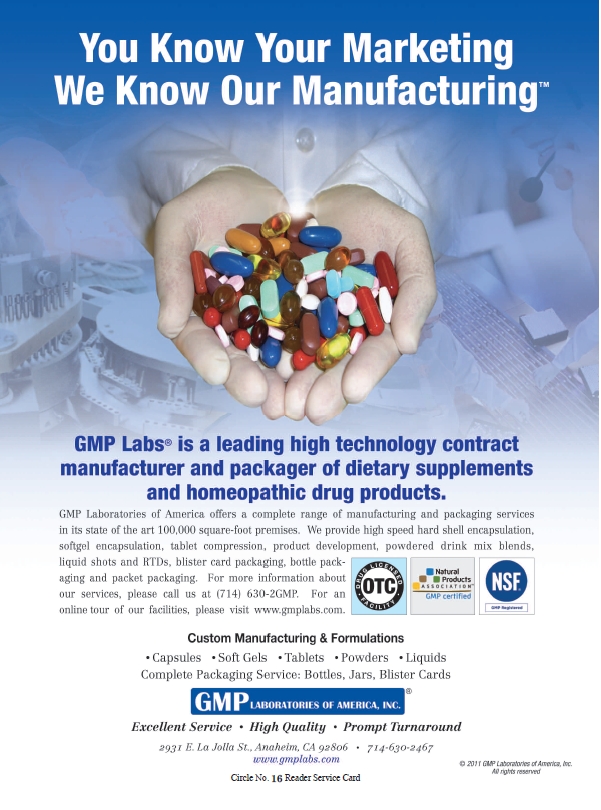 In the end, though, the ambiguity of regulatory liability may be hard to sort through. This is why product liability insurance brokers, according to Ung, always advise customers to have either the supplier or the marketer shoulder as much liability as possible. “Oftentimes, a broker has both manufacturers and marketing customers as their clients, so you can see how this can cause much confusion. The reality is that both sides need to show some responsibility by carrying their own product liability insurance,” Ung says, adding that today, more and more manufacturers are requiring customers to show proof of liability insurance before signing a contract.
In the end, though, the ambiguity of regulatory liability may be hard to sort through. This is why product liability insurance brokers, according to Ung, always advise customers to have either the supplier or the marketer shoulder as much liability as possible. “Oftentimes, a broker has both manufacturers and marketing customers as their clients, so you can see how this can cause much confusion. The reality is that both sides need to show some responsibility by carrying their own product liability insurance,” Ung says, adding that today, more and more manufacturers are requiring customers to show proof of liability insurance before signing a contract.
The Ideal Client
If they had their druthers, what traits would contract manufacturers love all their customers to bring to the table? Here, they come right out and tell us. Provenzano, for starters, likes a challenge, so customers that allow him to think “outside the box” for a solution are favorites of his. When it comes to his company’s sales representatives, most enjoy working with clients that have done their homework prior to contacting them. This may mean, he says, that they have a thoughtfully developed marketing plan, a concrete budget, an existing product formula and an idea of what they want on the first run, which can expedite the manufacturing process.
It can also be enjoyable, Provenzano says, for contract manufacturers to work with enthusiastic clients that have a great idea, but are in need of some guidance. Some of the largest companies for which his firm currently manufacturers started out this way, and have grown in a short period of time.
Too much trust right out of the gate can be bad thing. Ung looks for customers that seek to audit their manufacturers. He acknowledges that as a manufacturer, audits can soak up a lot of time and resources, particularly for quality control and regulatory departments that must spend time with the auditor to answer questions.
“However, the fact that a customer is spending their own time and resources to conduct the audit shows that this customer is looking for a long-term supply chain relationship,” Ung says. It conveys a similar focus on, commitment to and understanding of quality, and may reduce risk overall, because these types of marketers have their own regulatory department that will not allow them to make wild, unsubstantiated claims or to formulate and sell marginal products.
Similarly, Kaufman says that ideal clients are understanding of the resources required to properly address areas like GMP compliance. “That implies lots of testing which at times can be quite expensive and, of course, must be captured in the price of the product,” he says. Interactions with customers that understand these issues, rather than those that will focus solely on price savings, can include discussions of these compliance costs, and how money can be saved by the client placing large volume orders.
On this point, Akand contributes the notion that manufacturers that aren’t keeping up with compliance will need to start if they plan on staying in this industry, and when they do, they’ll need to pass on the cost to customers, too. Production expenses and the increasing price of quality control have changed the manufacturing business from what it was even five years ago, and informed clients know this. “So, they come to appreciate that the cost of maintaining quality is going up, and the cost that they pay will reflect that,” he says.
Akand also says that ideal customers are aware of what is and is not realistic in the realm of manufacturing. “In our industry, the formulations are provided to us, and a lot of times formulations are provided to us that may not be feasible,” he says. This can mean misapprehensions about how much can fit into a single capsule, or clients wanting ingredients that are problematic in certain contexts.
The other mode of awareness that can help the client–manufacturer relationship, he says, involves knowing that things cannot always happen overnight. The qualification process for incoming raw materials, and the built-in delay in receiving certain raw materials sometimes require several weeks. Ideal customers are aware that a certain lead time is to be expected due to these factors, and will therefore order ahead of time. They are also aware that issues can crop up unexpectedly in the manufacturing process, during tablet pressing or encapsulation, for example. WF
Published in WholeFoods Magazine, January 2013

